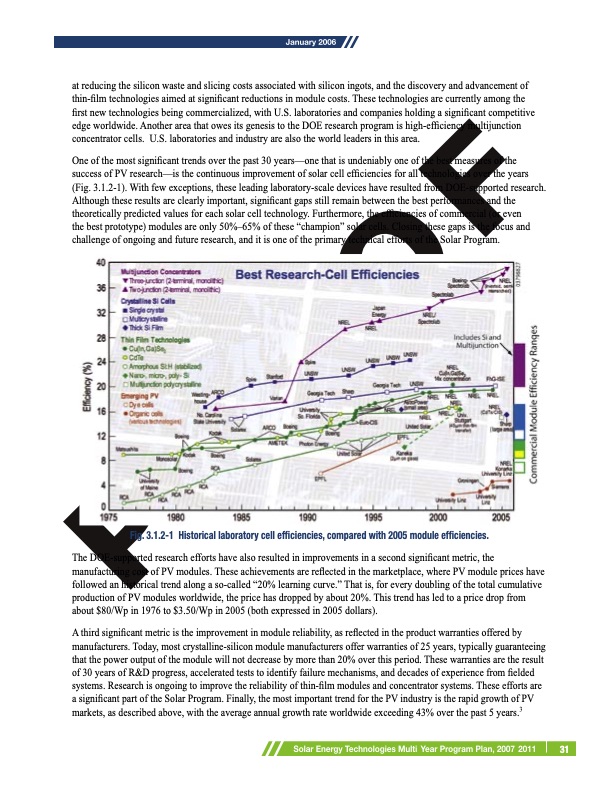
PDF Publication Title:
Text from PDF Page: 039
at reducing the silicon waste and slicing costs associated with silicon ingots, and the discovery and advancement of thin-film technologies aimed at significant reductions in module costs. These technologies are currently among the first new technologies being commercialized, with U.S. laboratories and companies holding a significant competitive edge worldwide. Another area that owes its genesis to the DOE research program is high-efficiency multijunction concentrator cells. U.S. laboratories and industry are also the world leaders in this area. One of the most significant trends over the past 30 years—one that is undeniably one of the best measures of the success of PV research—is the continuous improvement of solar cell efficiencies for all technologies over the years (Fig. 3.1.2-1). With few exceptions, these leading laboratory-scale devices have resulted from DOE-supported research. Although these results are clearly important, significant gaps still remain between the best performances and the theoretically predicted values for each solar cell technology. Furthermore, the efficiencies of commercial (or even the best prototype) modules are only 50%–65% of these “champion” solar cells. Closing these gaps is the focus and challenge of ongoing and future research, and it is one of the primary technical efforts of the Solar Program. Fig. 3.1.2-1 Historical laboratory cell efficiencies, compared with 2005 module efficiencies. The DOE-supported research efforts have also resulted in improvements in a second significant metric, the manufacturing cost of PV modules. These achievements are reflected in the marketplace, where PV module prices have followed an historical trend along a so-called “20% learning curve.” That is, for every doubling of the total cumulative production of PV modules worldwide, the price has dropped by about 20%. This trend has led to a price drop from about $80/Wp in 1976 to $3.50/Wp in 2005 (both expressed in 2005 dollars). A third significant metric is the improvement in module reliability, as reflected in the product warranties offered by manufacturers. Today, most crystalline-silicon module manufacturers offer warranties of 25 years, typically guaranteeing that the power output of the module will not decrease by more than 20% over this period. These warranties are the result of 30 years of R&D progress, accelerated tests to identify failure mechanisms, and decades of experience from fielded systems. Research is ongoing to improve the reliability of thin-film modules and concentrator systems. These efforts are a significant part of the Solar Program. Finally, the most important trend for the PV industry is the rapid growth of PV markets, as described above, with the average annual growth rate worldwide exceeding 43% over the past 5 years.3 31 �����PDF Image | Solar Energy Technologies Program

PDF Search Title:
Solar Energy Technologies ProgramOriginal File Name Searched:
set_myp_2007_2011_proof_1.pdfDIY PDF Search: Google It | Yahoo | Bing
NFT (Non Fungible Token): Buy our tech, design, development or system NFT and become part of our tech NFT network... More Info
IT XR Project Redstone NFT Available for Sale: NFT for high tech turbine design with one part 3D printed counter-rotating energy turbine. Be part of the future with this NFT. Can be bought and sold but only one design NFT exists. Royalties go to the developer (Infinity) to keep enhancing design and applications... More Info
Infinity Turbine IT XR Project Redstone Design: NFT for sale... NFT for high tech turbine design with one part 3D printed counter-rotating energy turbine. Includes all rights to this turbine design, including license for Fluid Handling Block I and II for the turbine assembly and housing. The NFT includes the blueprints (cad/cam), revenue streams, and all future development of the IT XR Project Redstone... More Info
Infinity Turbine ROT Radial Outflow Turbine 24 Design and Worldwide Rights: NFT for sale... NFT for the ROT 24 energy turbine. Be part of the future with this NFT. This design can be bought and sold but only one design NFT exists. You may manufacture the unit, or get the revenues from its sale from Infinity Turbine. Royalties go to the developer (Infinity) to keep enhancing design and applications... More Info
Infinity Supercritical CO2 10 Liter Extractor Design and Worldwide Rights: The Infinity Supercritical 10L CO2 extractor is for botanical oil extraction, which is rich in terpenes and can produce shelf ready full spectrum oil. With over 5 years of development, this industry leader mature extractor machine has been sold since 2015 and is part of many profitable businesses. The process can also be used for electrowinning, e-waste recycling, and lithium battery recycling, gold mining electronic wastes, precious metals. CO2 can also be used in a reverse fuel cell with nafion to make a gas-to-liquids fuel, such as methanol, ethanol and butanol or ethylene. Supercritical CO2 has also been used for treating nafion to make it more effective catalyst. This NFT is for the purchase of worldwide rights which includes the design. More Info
NFT (Non Fungible Token): Buy our tech, design, development or system NFT and become part of our tech NFT network... More Info
Infinity Turbine Products: Special for this month, any plans are $10,000 for complete Cad/Cam blueprints. License is for one build. Try before you buy a production license. May pay by Bitcoin or other Crypto. Products Page... More Info
| CONTACT TEL: 608-238-6001 Email: greg@infinityturbine.com | RSS | AMP |